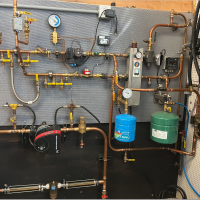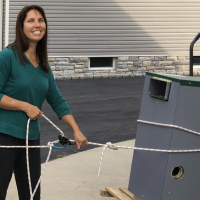Best Of
Re: Burnham Independent Near-Boiler Piping - Seeking Advice
It sounds like it's coming from the radiator, as if the vent is spinning around. But I also know that the source of water hammer is not always where you hear it. Need to do more investigating.
Thanks for the callout. Re: water quality, I'm north of Boston in a town known for its hard water.
Edit: Photos attached.



Unfortunately I don't know how it was sized. We had it installed before I knew anything about steam... regrettably I didn't ask all the great questions Dan calls out in We Got Steam Heat!.
Re: The case of the non heating steam system, this Friday's case
But the supply pipe for that radiator was in the wall behind the thermostat, heating it prematurely.
Re: 2 Pressuretrol Cut-Ins and 1 Cut Out?
You could probably convert that burner to LO-High fire. It's still going to cost a few bucks. You replace one of the gas valves with a two position Honeywell gas valve and hook the gas valve linkage to the air dampers.
There is a little more to it and the installer has to be competent with that burner. This would be cheaper that full modulation which in my opinion is a little overkill for a burner that size.
I was a Power Flame rep for 10 years now retired.
Re: Looking for help in south central kansas
Mkflyy said:
Grundfos UPS26-99FC Is the second added pump between the return manifold and water heater the other pump after expansion tank is a a grundfos up 15-42. Today I completely took the system apart to make sure there wasn’t an obstruction or something. I am using a 1/2 hp cast iron inline pump to fill and purge the system. I went through and did every loop individually after to starting with just the system loop then doing each individual loop. At this point I’m not opposed to adding a boiler but they are very expensive. I obviously don’t know what I am doing to install it either. Sounds like I would want a primary and secondary loop and I have looked at several diagrams and I can’t make sense of it and how I would add one to my system. So the last thing I want to do is buy a $2500 boiler and still not be able to get it to work. I also don’t have natural gas or LP only electric. That’s why I opted for this system.
Regardless of what's wrong, it must be corrected. First is, it needs to be an electric boiler, not an on demand water heater.
Then simply follow the boiler manufacturer piping instructions, and you'll be good to go.
 HVACNUT
HVACNUT
Re: Are there seriously no leveling shims I can just buy?
Re: 2 Pressuretrol Cut-Ins and 1 Cut Out?
The advantage of low/high/low firing is there is a small flame at start, high fire until roughly 1psi steam pressure, and back to low fire until the call for heat is satisfied or the pressure goes above say 2psi. With modulating burners, the flame (in theory) stays on even longer and you get more even heating and less short cycling. Ideally, a modulating burner would allow the boiler water to "simmer" all day like the coal boilers did a hundred years ago. With modulating burners you need a special pressure control that sends a variable (modulating) signal to the burner. We don't talk specifics about pricing, but I would guess a special order modulating burner with controls would cost you more than double the cost of the existing burner.
Re: Water line over 2” drop
I kind of wonder if you are trapping water in the main, probably should be an eccentric coupling or changed so it drains properly.

Re: 2 Pressuretrol Cut-Ins and 1 Cut Out?
The previous owners did a remodel and added radiant water heating in the back part first floor. That is why the current boiler is oversized (took out probably 2-3 large radiators).reggi said:What is the spare boiler for ?
Re: Cleaning my SEP4 - how often?
Flush into a bucket to see what flows out. If it always flows black colored you still have magnetite particles swimming around
Be sure the fill valve us working and on when you flush
When it finally runs clean, maybe squirt a hydronic conditioner into the system , to stop further corrosion, or at least slow it down
 hot_rod
hot_rod
Re: Repeated Air in Fuel/Fuel Line
This is actually incorrect use of the valve terminal. The motor terminal should power the inducer along with a proving switch of some type. the proving switch will then allow the burner motor to start. with your set up on the "valve Terminal" operating the inducer, the control can get incorrect diagnostic information from a problem with the inducer.



